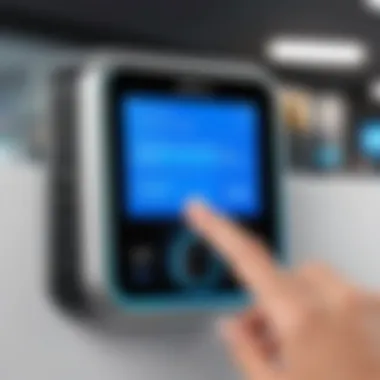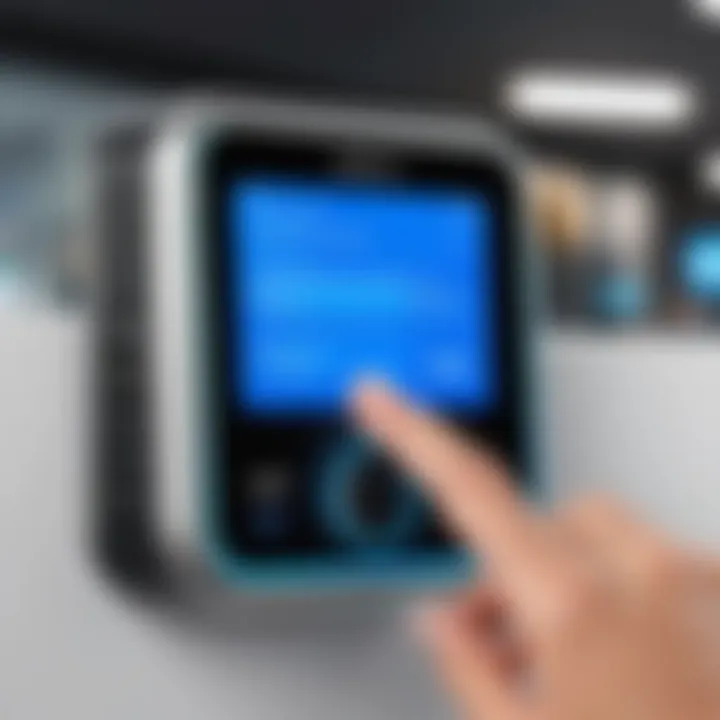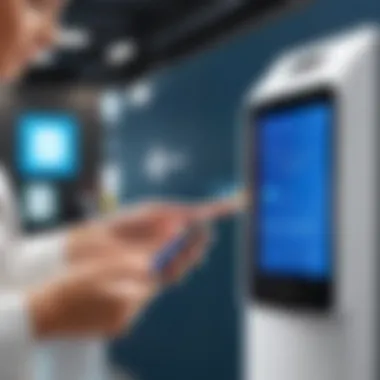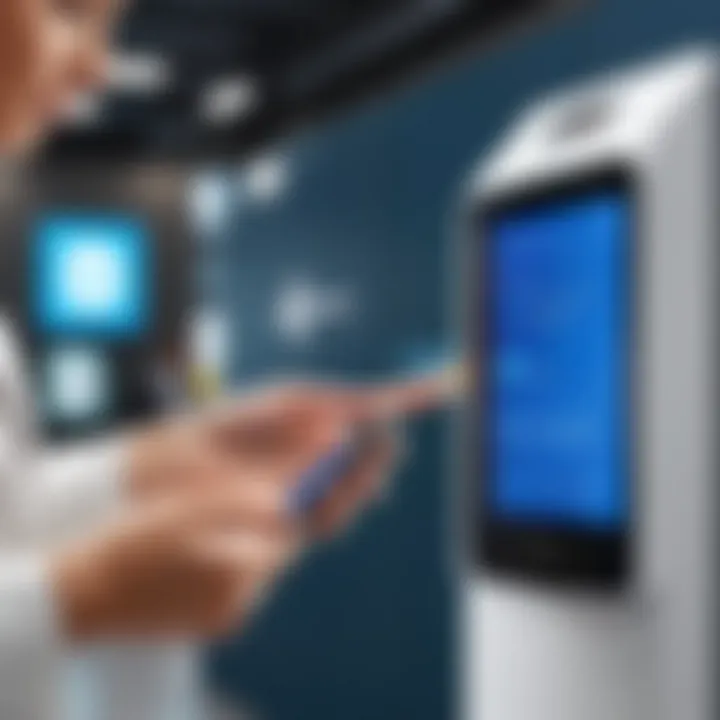Revolutionizing Attendance with Contactless Systems


Intro
The dynamics of workforce management have evolved substantially over recent years. The push for efficiency and accuracy has resulted in the rise of contactless attendance systems. These systems are more than just a trend; they are a necessary innovation in managing modern work environments. As organizations increasingly prioritize employee safety and streamlined operations, understanding the nuances of contactless attendance technology becomes essential.
Software Category Overview
Definition and Importance
Contactless attendance systems refer to technologies that allow organizations to track employee attendance without the need for physical interaction. This can include biometric systems, RFID technology, and mobile applications. The value of these systems lies in their ability to enhance operational efficiency, reduce time theft, and minimize human error. Moreover, in a post-pandemic world, the importance of contactless solutions has never been clearer. They promote health safety by reducing physical touchpoints.
Key Characteristics
Several key characteristics define effective contactless attendance systems:
- User-Friendly Interface: A simple interface ensures that employees can easily check in and out without confusion.
- Integration Capabilities: These systems should easily integrate with existing HR software for seamless data management.
- Real-Time Tracking: Instant data availability allows for timely payroll processing and performance tracking.
- Data Security: Protecting sensitive attendance data is crucial, necessitating robust security measures like encryption.
Comparative Analysis of Top Software Options
Feature Comparison
When evaluating different contactless attendance systems, it's imperative to consider specific features:
- Biometric Recognition: Systems like ZKTeco or uAttend utilize fingerprint and facial recognition to ensure accurate attendance tracking.
- Mobile Check-In: Applications such as TSheets or Deputy provide location-based check-ins, allowing remote employees to log their hours effortlessly.
- Reporting Capabilities: Advanced reporting from systems like Kronos or TimeClock Plus offers insights into attendance patterns and absenteeism.
Pricing Models
Pricing can vary widely among different vendors. Here are some common structures:
- Subscription-Based: Monthly subscriptions are common, with tiers based on the number of users or features accessible.
- One-Time Fee: Some software, like ClockShark, may offer a one-time purchase option along with ongoing support fees.
"Choosing the right attendance system can dramatically improve both efficiency and employee satisfaction."
Prelims to Contactless Attendance Systems
In today's rapidly evolving work environment, the need for efficient and accurate attendance management is more crucial than ever. Contactless attendance systems represent a significant advancement in this area, offering organizations mechanisms to monitor employee presence without the need for physical contact. This shift brings with it numerous benefits that can streamline operations, enhance data accuracy, and promote workplace safety.
Definition and Overview
Contactless attendance systems utilize various technologies to identify and record the presence of an individual without necessitating physical interaction with the system. This can encompass methods such as radio frequency identification (RFID), biometrics, and mobile applications. These systems track attendance in real-time, ensuring that data compilation is both seamless and immediate. The effectiveness of contactless systems lies in their ability to minimize human error and optimize administrative tasks, subsequently reducing the labor involved in managing attendance records. Their automatic nature fosters a culture of responsibility among employees, as they are aware that their attendance is being monitored efficiently.
Historical Context
The history of attendance systems is a reflection of technological advancements in workplace management. Traditional systems, such as punch cards and sign-in sheets, often relied heavily on manual input. These methods were prone to errors, such as buddy punching, where one employee signs in for another. The introduction of biometric systems, such as fingerprint scanners, marked a pivotal shift, as they offered a more secure and verifiable way to track attendance. However, while these systems addressed some inefficiencies, they still required close contact, which posed health risks especially in environments where hygiene is paramount. As a result, the recent transition to contactless attendance solutions has become not just an innovation but a necessity, especially during health crises like the COVID-19 pandemic. This evolution has paved the way for organizations to adopt systems that are more efficient, hygienic, and adaptable to the demands of modern work settings.
Mechanics of Contactless Attendance Systems
Understanding the mechanics of contactless attendance systems reveals their impact on organizational workflow and efficiency. These systems employ various technologies to track attendance without physical interaction. This transition to contactless solutions addresses modern workforce needs, enhancing both safety and accuracy in time monitoring.
Technologies Utilized
RFID Technology
RFID (Radio Frequency Identification) technology plays a pivotal role in contactless attendance systems. This system uses radio waves to transmit data between tags and readers. One key characteristic of RFID technology is its ability to work from a distance without the need for line-of-sight. This feature is particularly advantageous in busy environments where employees check-in or out simultaneously.
The benefit of RFID lies in its speed and simplicity. Users can simply walk past RFID readers without needing to tap or swipe cards. However, there are some disadvantages. For instance, RFID systems can be expensive to implement and may require extensive infrastructure.
Biometrics
Biometric attendance systems are another significant advancement. They rely on unique human traits, such as fingerprints or facial recognition. One notable characteristic of biometric systems is their high level of security. Each individual's biometric data is unique, making it hard to forge or share.
This technology is beneficial as it greatly reduces instances of buddy punching, where one employee clocks in for another. On the downside, biometric systems can raise privacy concerns among employees, leading to resistance in adoption. There can be also technical issues like misidentification in varied lighting conditions.
Mobile Applications
Mobile applications are increasingly being used in contactless attendance systems. The ability to log attendance via smartphones offers convenience. A significant feature of these apps is their accessibility; employees can manage attendance from anywhere.
These applications typically incorporate GPS tracking and time stamps, which adds to their effectiveness. However, they may depend heavily on reliable internet connectivity, which can be a disadvantage in areas with limited access.
Data Collection Processes
The data collection processes in contactless attendance systems are crucial for accurate record-keeping. These systems automatically gather attendance data, reducing the potential for human error.
Key different methods include:
- Real-time data capture through RFID, biometrics, or mobile applications.
- Centralized databases that streamline data storage and management.
- Advanced analytics that help organizations monitor attendance trends and anomalies.
The automation of data collection enhances efficiency. Organizations can quickly generate reports, helping managers make informed decisions regarding workforce management. Furthermore, this improved data accuracy contributes to better compliance with attendance policies.
"The mechanics of contactless attendance systems signify a major shift in how organizations monitor time and attendance, prioritizing efficiency and safety."
In summary, the technologies utilized in contactless attendance systems lay a strong foundation for improving attendance management. By understanding these technologies and their implications, organizations can make informed decisions regarding their implementation.
Advantages of Implementing Contactless Attendance Systems
Contactless attendance systems offer organizations numerous advantages that enhance efficiency, data accuracy, and workplace safety. As businesses navigate the complexities of modern workforce management, the benefits of these systems cannot be overlooked. Implementing contactless technology can change the way organizations monitor attendance, making it more streamlined and reliable.
Efficiency in Time Management
In today’s fast-paced work environment, time is a valuable resource. Contactless attendance systems significantly improve time management. Traditional methods often involve manual processes that take time and are prone to errors. With a contactless system, employees can check in and out swiftly. This is normally done through RFID scanners or mobile applications, reducing the minutes spent on administrative tasks.
The automated processes free up human resources for other important activities. For example, HR departments can focus more on strategic planning instead of repetitive attendance tracking. Moreover, real-time attendance data allows management to react quickly to attendance issues, ensuring workforce resources are optimized. The overall effectiveness of a company can be enhanced when time is used judiciously.
Enhanced Data Accuracy
Data integrity is a critical aspect of attendance tracking. When employing contactless attendance systems, organizations benefit from increased accuracy in attendance reports. Unlike manual processes that can involve human error, automated systems capture and log data effortlessly. This ensures information reflects actual attendance patterns without discrepancies.
With enhanced data accuracy, companies can conduct more reliable analyses for payroll, performance reviews, and resource allocation. Automation minimizes the risks associated with clocking errors and buddy punching, where one employee clocks in for another. Accurate records support compliance with labor laws and help avoid potential disputes.
Workplace Safety Considerations
In the wake of recent global events, workplace safety has gained unprecedented importance. Contactless attendance systems improve safety across organizations. By eliminating the need for physical touch points, like sign-in sheets or card scanners, these systems contribute to a healthier working environment. Employees feel more secure knowing that they are protected from unnecessary contact, which can reduce the spread of contagious diseases.
Moreover, the ability to track attendance in real-time helps organizations manage emergencies effectively. If an incident occurs, having accurate records can be crucial for ensuring the safety of all personnel. Systems that integrate with emergency response tools can provide instant access to the list of employees present at any given time, facilitating swift action if required.
Challenges in Adoption and Implementation
The topic of challenges in adoption and implementation is pivotal for understanding the practicalities associated with contactless attendance systems. Despite their clear advantages, organizations face several hurdles when integrating these systems into their existing frameworks. Acknowledging these challenges allows decision-makers to devise robust strategies for smoother transitions and better overall outcomes. Identifying the specific issues at hand can help organizations prepare more effectively and align their resources accordingly.
Technical Limitations
One of the major challenges is the technical limitations of contactless attendance systems. Some systems depend heavily on specific technologies, such as RFID or biometrics. This reliance raises concerns about compatibility with existing infrastructure. For example, if an organization uses older hardware that is not compatible with current attendance systems, it may incur unexpected costs in upgrades or replacements. Moreover, environmental factors can impede functionality. In locations with high electromagnetic interference, the efficacy of RFID might diminish. Testing is crucial before full-scale rollouts to avoid operational disruptions.


Employee Resistance
Another integral challenge is employee resistance to adopting these systems. Many employees may feel apprehensive about the implications of contactless monitoring. Concerns about surveillance and privacy can evoke discomfort. Communication becomes essential here; organizations should educate staff on how these systems enhance workplace efficiency and safety rather than infringing on their personal space. Clear explanations regarding data usage and security can foster a more accepting atmosphere.
Cost Implications
Cost implications also present a substantial barrier. While contactless attendance systems can improve efficiency and accuracy, the initial investment can be prohibitively high for some organizations. Costs associated with hardware, software, and implementation can quickly accumulate. Organizations must also consider ongoing maintenance and potential future upgrades. Careful budgeting and consideration of return on investment (ROI) are crucial. Some organizations may find it beneficial to compare various solutions and conduct cost-benefit analyses to ensure that the new system aligns with financial goals.
"Understanding challenges in adoption is as critical as recognizing the benefits of contactless attendance systems.”
Organizations who effectively address these challenges can maximize the success of their contactless attendance systems. Proper planning, employee engagement, and financial foresight are essential steps that guide successful implementation.
Integration with Existing Systems
Integrating contactless attendance systems with existing organizational infrastructures is a pivotal step in enhancing their effectiveness. Organizations already utilize various systems for managing human resources, payroll, and scheduling. The seamless incorporation of contactless attendance systems into these existing frameworks is not just a matter of convenience; it significantly influences operational efficiency and data management capabilities.
Compatibility with HR Software
Ensuring compatibility with HR software is crucial for the successful implementation of contactless attendance systems. Various HR systems are designed with specific functions like payroll processing and employee data management. Without proper integration, valuable data may become isolated, leading to inefficiencies in reporting and decision-making.
When attendance data is collected and automatically synced with HR software, it simplifies payroll tasks. This reduces the risk of errors associated with manual entry of hours worked. Moreover, having real-time attendance data allows HR teams to gain insights into workforce behavior, productivity patterns, and overall attendance trends.
To realize these benefits, organizations should assess their current HR software capabilities. Some HR platforms may offer APIs that facilitate integration. Others might require more complex setups to achieve compatibility. Thus, employers must evaluate their chosen attendance solutions against their existing HR systems to ensure a smooth transition.
Data Security Measures
Incorporating data security measures is paramount when integrating contactless attendance systems with existing infrastructures. As organizations handle sensitive information, it is essential to ensure that attendance data is safely collected, stored, and transmitted. This becomes increasingly important given the rising instances of cyber threats targeting organizational data.
To protect against potential risks, organizations should adopt several key strategies:
- Encryption: This involves converting attendance data into a coded format, which can only be decrypted by authorized systems or individuals. It significantly adds a layer of protection against unauthorized access.
- Access Controls: Implementing strict access controls ensures that only authorized personnel have the ability to view or manipulate attendance data. This limits exposure to potential breaches.
- Regular Audits: Conducting routine security audits can help identify vulnerabilities in the integration process and the data handling practices.
- Compliance with Regulations: Organizations must also consider legal regulations regarding data protection, such as the General Data Protection Regulation (GDPR) in Europe. Maintaining compliance not only protects the organization from legal penalties but also builds trust with employees.
"A proactive approach to security minimizes risks and enhances trust in the entire system."
In summary, the integration of contactless attendance systems with existing frameworks is essential for optimizing efficiency and ensuring data integrity. Focusing on compatibility with HR software and robust data security measures lays a solid foundation for the successful implementation of these systems.
Real-World Applications of Contactless Attendance Systems
The application of contactless attendance systems has reshaped how organizations manage workforce monitoring. From tracking attendance efficiently to promoting safety and accuracy, these systems are now pivotal in various sectors. Embracing these technologies is not merely about staying current but about enabling better operational results.
Corporate Environments
In the corporate world, the adoption of contactless attendance systems enhances productivity. Companies utilize these systems to streamline their time-tracking processes. The technology allows workers to clock in and out without physical interaction, minimizing distractions and ensuring that employees focus on work tasks.
Benefits of implementing contactless attendance in corporate settings include:
- Improved Time Tracking: Automatic logs reduce human error and provide real-time data.
- Increased Worker Satisfaction: Employees appreciate the convenience of quickly registering their attendance without unnecessary delays.
Additionally, these systems contribute to compliance with labor regulations by accurately tracking hours worked. Firms experience not only operational efficiencies but also avoid potential legal complications from imprecise record-keeping.
Educational Institutions
Schools and universities have also reaped significant rewards from contactless attendance systems. These technologies simplify the task of monitoring student attendance. For example, biometric identification, like fingerprints or facial recognition, can efficiently verify student identities when they enter or exit facilities.
Main advantages of using such systems in educational settings are:


- Real-time Attendance Data: Educators can quickly access current attendance, ensuring timely intervention if necessary.
- Enhanced Security Measures: Monitoring who is on campus at any given time contributes to safer environments for both staff and students.
Moreover, students benefit from reduced wait times during attendance taking, leading to more time spent on learning and less on administrative tasks.
Healthcare Settings
In healthcare, contactless attendance systems play a critical role. Hospitals and clinics must maintain strict attendance records for staff, and implementing these systems ensures that patient care does not suffer. Moreover, visitors also benefit from faster entry processes.
Considerable benefits in healthcare sectors include:
- Compliance with Regulatory Requirements: Accurate attendance records are essential for meeting industry standards.
- Improved Patient Care: Staff spending less time in queues can attend to patient needs more effectively.
Furthermore, the integration of attendance systems with patient management software can be beneficial. This connection ensures that healthcare facilities can operate efficiently while maintaining high service quality.
"In an increasingly digital world, embracing contactless attendance systems can translate into competitive advantages for organizations across all sectors."
Overall, the impact of contactless attendance systems in these three areas illustrates their versatility and importance in modern organizational management. These systems not only enhance operational efficiencies but also contribute significantly to safety, validation, and compliance in a fast-evolving landscape.
Future Trends in Attendance Management
As organizations adapt to rapid changes in the landscape of work, understanding future trends in attendance management is essential. This section discusses innovations and how they can reshape attendance tracking and monitoring. By keeping an eye on these trends, organizations can improve efficiency and enhance employee experiences.
Integration with AI and Analytics
Integrating artificial intelligence (AI) and analytics into contactless attendance systems presents significant advantages. AI can process large volumes of attendance data in real-time, uncovering patterns that human analysis might miss. This capability allows organizations to optimize resource allocation within their workforce.
For instance, AI can predict attendance trends based on historical data, which helps in staffing decisions and project planning. Using predictive analytics, decision-makers can see potential attendance challenges before they occur. This proactive approach can lead to efficient scheduling and reduce instances of understaffing or overstaffing.
Another key benefit of AI integration is the potential for personalized employee experiences. By analyzing attendance data, AI algorithms can suggest flexible work arrangements that match individual preferences and needs. Employers can then tailor policies to enhance job satisfaction and retention.
Remote Work Considerations
The increasing prevalence of remote work demands that organizations rethink their attendance management strategies. Traditional attendance systems do not adequately accommodate the needs of a distributed workforce.
Contactless attendance systems can be adapted to include geo-fencing and mobile applications. For example, employees might clock in and out using their smartphones from different locations. This capability supports a versatile work environment, ensuring that attendance is tracked accurately, regardless of where work is conducted.
Additionally, organizations need to consider how engagement can be maintained in remote settings. Regular check-ins through software platforms can foster communication and accountability. By leveraging these tools, managers can better understand how remote work impacts performance and attendance patterns.
"Future attendance systems must accommodate flexibility while maintaining accountability."
A focused approach to these developments will enable organizations to remain competitive in an evolving work culture.
Finale
The conclusion serves a crucial role in summarizing the insights discussed throughout this article on contactless attendance systems. It highlights the relevance of these systems in today’s dynamic workforce. Organizations across various sectors face the challenge of efficient time monitoring, and contactless systems provide a solution by enhancing operational efficiency and promoting workplace safety.
Summary of Key Insights
Contactless attendance systems leverage advanced technologies like RFID, biometrics, and mobile applications. These technologies facilitate accurate data collection and allow immediate analysis, ultimately improving decision-making processes. Furthermore, their integration into existing systems can streamline human resource management.
"Implementing contactless attendance systems not only saves time but also enhances data accuracy, fostering a transparent work culture."
In various environments, from corporate offices to healthcare settings, the systems demonstrate their versatility, addressing unique challenges each sector faces in attendance management. Key takeaways include:
- Efficiency Improvement: Significant reduction in time wasted during roll calls or sign-ins.
- Enhanced Data Accuracy: Automated processes minimize human error.
- Workplace Safety: Minimizing contact helps in reducing infection risks.
Final Thoughts on Implementation
Implementing contactless attendance systems requires careful consideration of several factors. Organizations must analyze the initial costs versus the long-term benefits. Employee acceptance is also critical; proper training and clear communication can mitigate resistance to new technologies. Organizations should focus on:
- ROI Analysis: Conducting a thorough return on investment assessment to justify expenses.
- User Training: Educating employees on the benefits and functionalities of the new system to foster acceptance.
- Support Systems: Establishing ongoing support post-implementation to address any technical issues that may arise.







